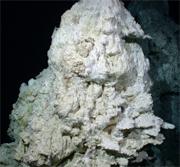 This calcium carbonate chimney is home to many unusual species.© University of Washington
This calcium carbonate chimney is home to many unusual species.© University of WashingtonThe towering limestone chimneys of Lost City, a unique field of hydrothermal vents deep beneath the Atlantic Ocean, are packed with unusual life forms, say scientists.
Five years ago, a team of US and Swiss researchers stumbled upon this system of seafloor geysers while studying an underwater mountain.
"It was incredibly exciting," says Deborah Kelley, an oceanographer at the University of Washington in Seattle, who is part of the team. Kelley says she was immediately impressed by the immense white spires that released "gently billowing fluids".
The team had time for only one five-hour dive in Alvin, a deep submersible vehicle the size of a small truck. But the researchers returned in 2003 to investigate the links between the geology, fluid chemistry and biology of these vents, and they document them in this week's Science1.
In the limelight
In the last 30 years, more than 200 vent fields have been discovered. Many lie along mid-ocean ridges where hot magma seeps through the Earth's crust, reacting with sea water to create a hot, acidic, sulphide-rich environment. Minerals in this water harden into black-smoker chimneys, whose emissions sustain diverse microbes, which in turn provide food for a thriving community of tubeworms, clams and shrimp.
But Lost City is different. It lies about 15 kilometres away from the Mid-Atlantic Ridge, near the top of the Atlantis massif, a mountain that is over 4,000 metres tall. Sea water trickling deep into the massif reacts with mantle rock that is 1.5 million years old.
The reaction releases heat and dissolves some of the minerals in the rock to form warm, alkaline water that rises from fractures in the sea floor. The water can reach 90°C and pH 11. When it meets cooler sea water, calcium carbonate precipitates, which gradually builds up the chalky chimneys.
City dwellers
The inside walls of these porous spires house a colony of archaea that have adapted to a diet of hydrogen and methane, which also rise from the vent beneath. "This is one of the significant findings of this study," says Stefan Sievert, a microbiologist at Woods Hole Oceanographic Institution in Massachusetts. "The whole system seems geared toward methane production or methane consumption," he says, which is "the kind of system that might have been present on the early Earth".
ADVERTISEMENT
A diverse range of life feeds on these primitive archaea at Lost City. But whereas the hallmark of the black-smoker systems are tubeworms well over a metre long, most of the fauna of the Lost City vents, including nematodes and bivalves, are transparent and no longer than a centimetre. This makes the vent landscape look relatively barren.
But appearances are deceptive, says Kelley. "Lost City highlights the potential there still is for big discoveries to be made on the planet," and she expects similar vents to exist in other locations. "We really don't know what microbes are there or what they're doing," she adds, predicting that, "In the next ten years, profound discoveries will be made."
